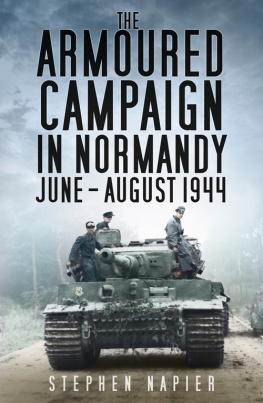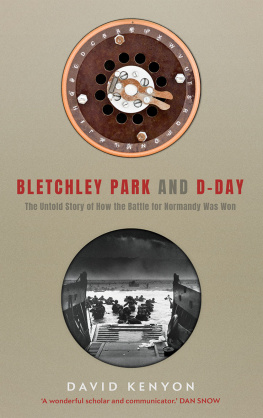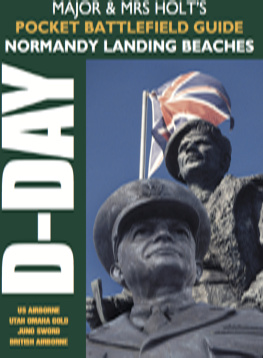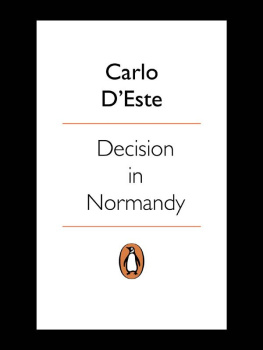This edition is published by Arcole Publishingwww.pp-publishing.com
To join our mailing list for new titles or for issues with our books arcolepublishing@gmail.com
Or on Facebook
Major David S. Wilson 2018, all rights reserved. No part of this publication may be reproduced, stored in a retrieval system or transmitted by any means, electrical, mechanical or otherwise without the written permission of the copyright holder.
Publishers Note
Although in most cases we have retained the Authors original spelling and grammar to authentically reproduce the work of the Author and the original intent of such material, some additional notes and clarifications have been added for the modern readers benefit.
We have also made every effort to include all maps and illustrations of the original edition the limitations of formatting do not allow of including larger maps, we will upload as many of these maps as possible.
THE NORMANDY CAMPAIGN: AN ANALYSIS
by
MAJOR DAVID S. WILSON
USA, RET.
TABLE OF CONTENTS
Contents
TABLE OF CONTENTS
REQUEST FROM THE PUBLISHER
ABSTRACT
Since the fiftieth anniversary of World War Two (1994), there has been an increased interest in the Normandy campaign. The Normandy campaign was a watershed event for the US Army and left a great influence. General William E. Depuy, the first commander of the Armys Cold War Training & Doctrine Command (TRADOC), was an infantry battalion operations officer in the 90 th Infantry Division which had the very mission of encircling German forces in Normandy. Further, General Depuy was the author of the 1976 Field Manual FM 100-5 Operations and its concept of the active defense. Many would later compare US VII Corps Operation COBRA in Normandy to US VII Corps in Operation DESERT STORM and to the 1982 FM 100-5 Operations manual doctrine of AirLand Battle (ALB).
While General Depuy did not have direct influence in developing AirLand Battle, he did have an indirect influence in selecting the tenets of AirLand Battle: agility, depth, initiative and synchronization. If one studies the Normandy campaign, they will see the German defenders executing an active defense with units defending in depth (Caen) and counterattacking Allied advances. Also, displayed by the Germans was the agility of their staffs and troops to quickly move Kampfgroups (combat teams) around the battlefield and small unit leaders taking the initiative in executing their active defense. This led one British author, Max Hastings, to opine (1984) that NATO would be wise to emulate the Germans in Normandy, and hope that they too could execute such a determined and deliberate active defense.
Many have referred to Normandy as a logistical feat. I prefer to focus beyond the beachhead. By using ratios and attrition of combat power, I will attempt to provide a quantitative analysis of the Normandy campaign. This campaign is still important today based on the above anecdotes; Normandy covered the full spectrum of war: the defense and the offense. It is through studying the Normandy campaign we can extract valuable lessons learned relevant to the art of operational-level warfare.
TABLE OF ILLUSTRATIONS
Fig. 1: Map: Normandy 6 June 1944
Fig 2: Picture: US troops capture Cherbourg
Fig. 3:. Map: Operations EPSOM, CHARNWOOD and GOODWOOD
Fig. 4: Order of Battle: 1 st US Army vs German 7 th Army (Operation COBRA)
Fig. 5: Map: Operation COBRA, 25 July 1944
Fig. 6: Picture: US tank passing abandoned German tanks, Operation COBRA
Fig. 7: Map: Operation LTTICH, Mortain Counterattack, 7 August 1944
Fig. 8: Chart: Allied-Germans Forces, August 1944, (Closing the Falaise Gap).
Fig. 9: Map: Closing the Falaise Gap, 9-16 August 1944
LIST OF ABBREVIATIONS
Abn-Airborne (parachute forces)
AD-Armored Division (US, UK)
AGF-Army Ground Forces (US Army headquarters and training command, WW 2)
BR-British (UK) Forces
CCA-Combat Command A (B and Reserve), US armor brigade for a US armor division
CGSC-Command & General Staff College (Fort Leavenworth, US Army)
CD-Canadian Forces
ETO-European Theater of Operations (US)
FJ-Fallshirmjger (German Luftwaffe parachute troops)
FM-Field Manual (US Army)
FR-Free French Forces
GER-Germany
ID-Infantry Division
KFG-Kampfgroup (German regimental combat team)
OB West-Ober Kommando West (German headquarters for Western Europe)
OKW-Ober Kommando Wehrmacht (German high command)
POL (AD)-Free Polish Army (1 st Polish Armored Division)
PZ-German Panzer (armor) Division
SHAEF-Supreme Headquarters Allied Expeditionary Force
StuG-Sturm Geshutz (German assault gun tank)
TRADOC-Training and Doctrine Command (US Army, established 1973)
CHAPTER ONE-INTRODUCTION
Since the fiftieth anniversary of World War Two (1994), there has been an increased interest in the Normandy Campaign. Further, in the 1980s there were numerous books written on the campaign, mainly for the purpose of challenging biographies of Allied generals written during the 1950s and 1960s. Adding further interest to Normandy has been the renewed interest in conventional warfighting starting in the mid-1970s following Americas military defeat in Vietnam and the Israeli experience in the 1973 Yom Kippur War. Overall, there are several good books written on Normandy, and it is not my intention to reiterate them.
It is my goal to fill a professional void created by those books. These books are written from an academic point of view and not from the view of a military staff officer. Further, in the 1970s came the development of the concept of Combat Multipliers by Colonel Trevor N. Dupuy. By using computer models, Dupuy was able to study World War II. What is most profound is not that his ratios predicted an Allied victory, but he found that leadership, morale and fire support (air and artillery) modified the combat power of units.
At the same time in the 1970s, the US Army was publishing its new doctrinal manual, Field Manual 100-5, Operations , (FM 100-5), focusing on the active defense. This revised manual used the ratios that Dupuy had discussed. However, these ratios were removed from the 1982 version of FM 100-5 (Airland Battle) as being too attrition oriented. Even though Dupuy criticized the Armys combat ratios, the US Armys Command & General Staff College (CGSC) at Fort Leavenworth student staff manual ST 100-9 (dated 1994) still retained ratios in wargaming and includes Dupuys very own movement rates.
Also, part of ST 100-9 is the importance of wargaming. Today, wargaming, called battle simulations, is an important part of military staff training. It is no coincidence that during the opening shots of the Normandy campaign, the German VII Army staff was busy conducting a wargame of an Allied invasion.
The Normandy campaign was a watershed event for the US Army and left a great influence. {1} General William E. Depuy, the first commander of the newly created US Army Training & Doctrine Command (TRADOC), and the author who wrote the 1976 version of FM 100-5, Operations , fought in Normandy as a battalion operations officer of the ill-fated 90 th Infantry Division. While the tenets of Airland Battle doctrine would not be published until the 1982, FM 100-5, Operations manual, General Depuy had an institutional influence on the selection of those tenets: Agility, Depth, Initiative and Synchronization. If one studies the Normandy campaign, they will see the German defenders executing an active defense with units defending in depth (Caen) and counterattacking penetrations. Also, displayed by the Germans was the agility of their staffs and troops to quickly move Kampfgroups (combat teams) around the battlefield and small unit leaders taking the initiative in executing their active defense.











